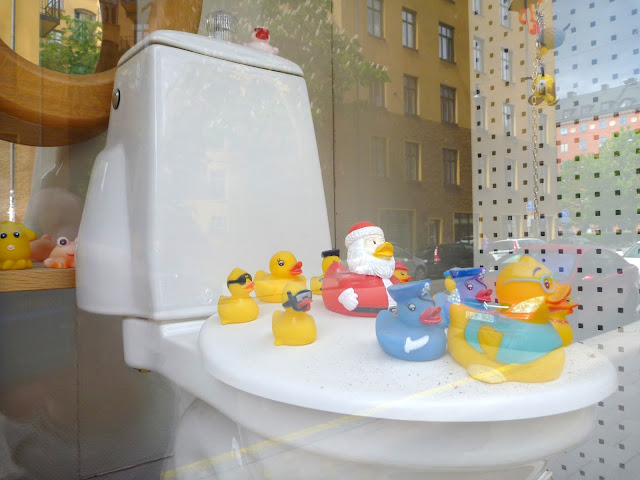Sodermalm is the district where we stayed and this was our hotel: Rival. We had a very comfortable stay there, and were pleased to find out that it's owned by Benny Anderson of ABBA.

A gorgeous little park was the first thing that greeted us as we walked out of the hotel
with a huge fountain and statue in the middle
enormous for the size of the park.
During both Friday evenings of our stay this small tent would be set up in the park. We could not figure out what was going on - some form of story-telling, we thought. I asked two Swedish women what it was but they were as bemused as we were.
Two café/bars next to the hotel became our base for pre-dinner drinks every evening (this by the way, was taken at 11:30 at night, and it was still not completely dark)
Swedenborgsgatan was nearby, a street full of bars and restaurants, so very convenient.
I liked this gate that was nearby
and this sculpture of mother and child by Karl Hulstrom
Sodermalm is on one of Stockholm's larger islands - it was traditionally a working class district, but in recent years has developed more of a 'bohemian chic' character and has an abundance of restaurants, cafes and designer shops.
Sodermalm is best known for two reasons. The first one is because this is where Stieg Larsson's Millenium Trilogy is set. Mikael Blomvist lives here; this is where Lisbet Salander grew up; Blomvist's hangout is here; the Millenium office is here;
Lisbeth buys a 350 square meter 21-room apartment on the top floor of a building like this. She only furnishes a few rooms and lives here in secret with the name V.Kulla on the door (Villa Villekulla is the name of Pipppi Longstockings house).
And so on... but I digress and I'm aware this is of interest only to Millenium Trilogy fans.
Most days would start with a walk to Slussen where we would take the metro or, more often, the ferry
This caught our attention one morning - it's very near the metro station
as is this bar.
Coming back in the late afternoons we would take a different route and walk up the Hornsgatan Bump, which is the old course of the Hornsgatan (one of the wide avenues of the district), which remained when the street was bulldozed and widened at the start of the 20th century.
Dararnas Bat, Sture Collin
The second reason why Sodermalm is known is because of SoFo, an area on the Eastern part of the district which is full of stylish clothing and design boutiques, and atmospheric cafes and bars. We walked along Folkungatan to get there. Lots of people in this little park which was on our way
where we also came across Restfest - a campaign to get supermarkets to donate rather than throw away left over food
the food was cooked on the spot - lasagne on the day we visited - and people were invited to partake without charge - a great initiative
a little while later we came across this sculpture
as well as this one on the corner of Katarina Bangat and Brannerigatan
a tribute to Nacka Skoglund, the football star. It's called 'See You at the Goal' and was made of stainless steel by the artist Olle Adrin.
Ducks galore in this bathroom shop
The Greta Garbo square on Katarina Bangata
Garbo was born in this neighbourhood in 1905.
This is by Thomas Qvarsebo
One of the many tattoo parlours in the city - the Swedes love tattoos
one of the many cafes in the area
We then reached Notroget, (the grass is not real grass, but artificial) the focal point of the area which is surrounded by cafes, restaurants

and wooden buildings.
The Urban Deli, a new deli-restaurant-café-shop, offering a New York-style take on the traditional Swedish locale - very popular
flowers.

We walked north and reached Katarinavagen, on top of the cliff

which afforded great views of the water
and of the small island of Kastellholmen and the citadel
below, Fotografiska, the excellent Museum of Photography
So down the steps we went.
After an extremely enjoyable and thought-provoking two hours at the museum we decided to walk back to our hotel taking the route along the water, which involved going up a hill
under the complex network of roads and bridges of Slussen
Once we left Slussen behind it was a very pleasant walk as is always the case in this magnificent, beautiful city which is so open and so green
The Stadhuset, the City Hall could be seen across the water. Designed by Ragmar Ostberg in 1923, it has a very distinctive 106-metre turret and this is where the Nobel Prize banquet is held every other December.
Most of the moored boats in this area are hotels
and soon we reached known landmarks and our hotel.















































Are you paying more than $5 / pack of cigarettes? I buy all my cigs at Duty Free Depot and I'm saving over 60%.
ReplyDeleteok
ReplyDelete